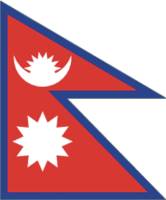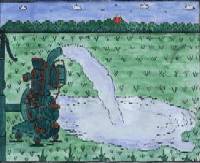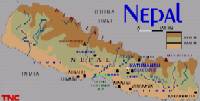Special Program for International Students
GRADUATE COURSE IN EARTH SCIENCE
& GEOENVIRONMENTAL SCIENCE
Current MEXT students
Jaya Kumar Gurung (Nepal)
Email: s049709 @matsu.shimane-u.ac.jp
Thesis title: Study of Arsenic Contamination in Groundwater in Nitrogen Cycle in Kathmandu Valley and Terai basin, Nepal.
Supervisor: Prof. Hiroaki Ishiga (2004-2007).
The Himalayan country of Nepal has tremendous water resources, but the potential benefit of utilization of these resources is limited due to inadequate knowledge of their geology and hydrology, and their complex relationship with the environment. A trend toward deteriorating water quality is now a prominent environmental issue in Nepal. It has been estimated that only 34% of the population have access to safe drinking water.
While I was working in the groundwater production sector in Nepal, the recently reported arsenic contamination in groundwater in the Terai Basin of Nepal compelled me to learn about the arsenic contamination mechanism and its relation to geology. Consequently, I joined Shimane University as a Special Course M.Sc. student in 2002-2004.
For my MSc research, I investigated the geology and geochemistry of Nawalparasi, one of the hotspot districts for arsenic contamination in Terai Nepal. This study included Holocene stratigraphy with 14C dating, core sediment analysis, and provenance study and rare earth elements analysis. From the results I inferred that reducing conditions and organic matter activity could be the two main factors responsible for arsenic release into groundwater in the Terai Basin.
Few studies of arsenic contamination in Nepal have been made to date, and most of the work so far has focussed on water chemistry and the epidemiological impact of arsenic on human beings. My study is the first attempt to examine the arsenic contamination from geological aspects, and my MSc thesis is one of the technical documents presently being used by the experts working on the arsenic issue. Research on arsenic in Nepal is only just beginning, and intensive study is needed before the problem can be thoroughly understood. It is imperative that all people have access to arsenic-free water.
In addition to arsenic, anomalously high concentrations of many other toxic elements or species such as iron, mercury, manganese, fluoride, and ammonia have also been reported from Nepal. Although some projects are examining these other toxic elements in the same areas where arsenic contamination exists, no attempt has not yet been made to integrate the study of all toxic elements, which could improve our understanding. Geochemical interrelationships among the toxic elements cannot be ruled out. For example, the balance in the interrelations of arsenic, iron, nitrate, and ammonia that is theoretically possible has not yet been studied. The need for such study of the relationships between arsenic and other toxic elements or species in groundwater (especially nitrogen compounds) provides the motivation for my further study.
Further study
The focus of my doctoral study is on the interrelationship between the geochemistry of aquifer sediments and the hydrochemistry of the groundwater. I will explore the possible relationship between the arsenic species and nitrogen compounds, and compare the mode of aquifer contamination by these two elements.
The study area is the southern Terai Basin and the capital city, Kathmandu, where the inhabitants are dependent in groundwater for their livelihood. Kathmandu Valley groundwater is highly prone to contamination. Some preliminary surveys have already reported contamination from arsenic, nitrate, and some heavy metals, but detailed studies have not yet been carried out.
The approach to be taken comprises both field works and laboratory work. Field work includes collection of sediment core samples and water samples, in situ measurement of physico-chemical parameters, establishing monitoring wells, and measurement of hydrogeological parameters for the study of aquifer characteristics. Laboratory analyses include the examination of water samples by Atomic Absorption Spectrometry, and analysis of core sample analyses by X-ray Fluorescence, XRD, and other methods. Isotopic analyses for d15 N and d13C will be made to trace the source of nitrate and ammonia. The age of the groundwater of the Kathmandu Valley will also be determined by radio carbon isotopes.
I hope my study will improve our understanding of the mechanism of arsenic release, the movement of arsenic, and the interrelationship between arsenic and nitrogen compounds. This study will contribute to making national guidelines for the future development of groundwater resources in both in the Kathmandu Valley and the Terai Basin Nepal.



